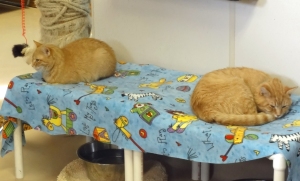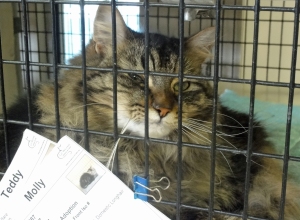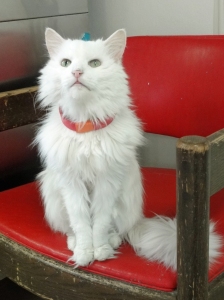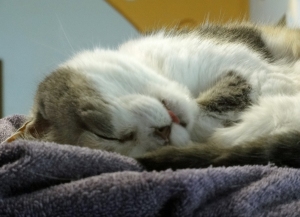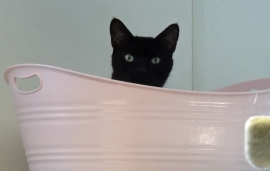In May I attended the Animal Care Expo in Nashville sponsored by the Humane Society of the United States. Animal rescue and sheltering is often dominated by dogs – cats are often an afterthought to the discussion even though there are more cats in homes than dogs, more homeless cats coming into shelters, and many more stray and feral cats roaming at large.

Some of the 2,000 people in the audience at the HSUS Animal Care Expo.
That’s why I was so happy to see consideration of cats get central billing at this conference, including a special plenary session on “Tipping Point 2013 – Radically Rethinking our Response to Cats” (handouts here in pdf). Led by the country’s top expert in shelter medicine, Dr. Kate Hurley of University of California at Davis College of Veterinary Medicine, the session also included Dr. Julie Levy of University of Florida and Jon Cicirelli, director of San Jose Animal Care and Services.
The session was an eye-opening look at a whole new paradigm for managing feral and stray cats. It will also be available for anyone to see through two webcasts sponsored by Maddie’s Fund:
I highly recommend that anyone interested in managing cat populations register for these events.
With up to 90 million feral and stray cats across the country, there is no way shelters can rehome them all – and feral cats are not suitable candidates for adoption anyway. Yet shelters have been admitting most of the stray and owned cats that people bring in to them, and euthanizing the majority for space. In California alone, Dr. Hurley said, shelters euthanized 2.5 million cats over 10 years – or 756 a day.
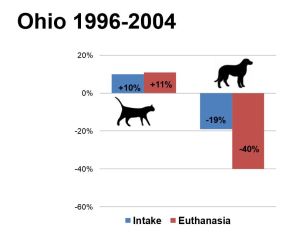
Credit: Kate Hurley
As Dr. Hurley’s presentation points out, these high levels of euthanasia are doing nothing to address cat overpopulation. In Ohio, for example, intake of cats into shelters rose 10 percent from 1996 to 2004, while the number of cats euthanized rose 11 percent. During this same time period, intake of dogs fell 19 percent and euthanasia fell 40 percent.
The problem is that even though shelters are euthanizing a lot of cats, they are taking in only a tiny fraction of cats in the environment. The rest are left out there to keep reproducing.
Of all cats in the outdoor environment in California in 2010, Dr. Hurley said, 61 percent were stray and feral, 35 percent were owned cats allowed to go outside, 3 percent were impounded and euthanized, and 1 percent were impounded and released.

Cat statistics in California. Credit: Kate Hurley
With only 3 percent of the outdoor cat population being euthanized while 61 percent remain untouched, there is no way shelter euthanasia will solve cat overpopulation. Only 2 percent of stray and feral cats are fixed, meaning the vast majority of that 61 percent will keep contributing to cat overpopulation. That is why intake of cats has continued to go up even as intake of dogs has fallen.
Dr. Hurley is proposing a whole new paradigm for shelter cats – taking in only as many as they can rehome. This proposal is the subject of a great deal of discussion and debate in the shelter community, because it feels wrong not to take every cat brought in for surrender.

Programs for cats in Alachua County. Credit: Julie Levy
Yet shelters that have implemented this new paradigm, such as Alachua County, Fla., are seeing success. What happens is that resources once spent on euthanizing large numbers of cats can now be spent on other programs, such as low-cost spay-neuter that addresses the root causes of cat overpopulation, and creative new adoption programs to place more cats than ever into new homes.

Cat statistics in San Jose. Credit: Jon Cicirelli
Nor is this translating into more suffering for cats as many have feared. In San Jose, the number of cats being hit by cars is actually down since the shelter implemented this program. At the Erie County SPCA, which implemented a waiting list for people to surrender cats, 14 percent of people on the list ended up keeping their cats while 50 percent were rehomed through another rescue group.
Dr. Hurley has figures showing that stray and feral cats are generally healthy and not suffering in their environment. Less than 1 percent of cats at Trap-Neuter-Return clinics are euthanized for humane reasons, while less than 10 percent of cats entering shelters are sick or injured.

Statistics from Alachua County. Credit; Julie Levy
In Alachua County, Fla., where Dr. Levy led implementation of this program, both cat intake and cat euthanasia have fallen precipitously since 1994. Friendly cats that can be adopted are placed into new homes. Healthy strays and ferals that cannot be placed are altered and returned to their environments. Only those cats that cannot be placed into a home and are not thriving in their environment are euthanized. Alachua County, Dr. Levy says, is “the safest place in Florida to be a cat.”
Of course the dynamics of cat overpopulation are complex, and it will take a variety of approaches to solve this issue. But until we tackle the root cause of so many cats being brought to shelters, we will never be able to bring down the number of cats being euthanized.
Rather than euthanasia, Dr. Hurley, Dr. Levy, and other experts are increasingly turning to managed admission of cats for shelters and trap-neuter-return for the large population of stray and feral cats. One reason I chose to raise money for Cat Welfare Association is they are practicing the very program these experts suggest, and have been since 1945.
Day 17 Swim Report
Number of laps: 45
Time: 75 minutes
Pace: Right at goal speed
I took a day off from swimming on July 16 in order to catch up on numerous work and home projects. Coming back I was a little worried about being slow, but was able to keep up with the pace I want to be at. The laps went by quickly, and I was able to finish on time.




